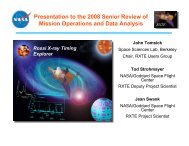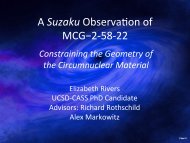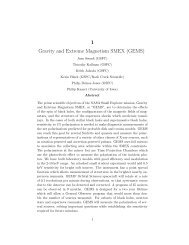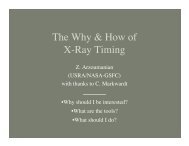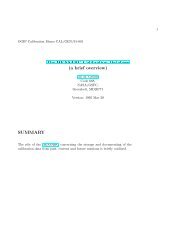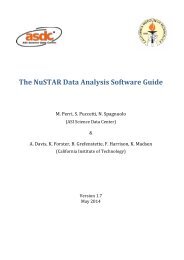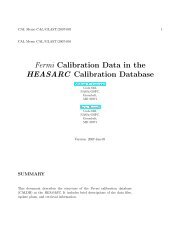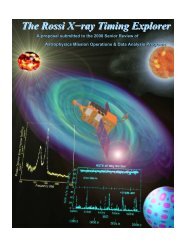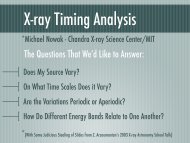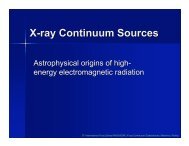Rossi X-ray Timing Explorer (RXTE) - HEASARC - NASA
Rossi X-ray Timing Explorer (RXTE) - HEASARC - NASA
Rossi X-ray Timing Explorer (RXTE) - HEASARC - NASA
Create successful ePaper yourself
Turn your PDF publications into a flip-book with our unique Google optimized e-Paper software.
<strong>Rossi</strong> X-<strong>ray</strong> <strong>Timing</strong> <strong>Explorer</strong> (<strong>RXTE</strong>)<br />
http://heasarc<br />
heasarc.gsfc.nasa.gov/docs/<br />
/docs/xte/xte_1st.html<br />
<strong>RXTE</strong> 1<br />
Fred Lamb<br />
Chair, <strong>RXTE</strong> Users Group<br />
<strong>RXTE</strong>
<strong>RXTE</strong> 2<br />
<strong>RXTE</strong> Results Cover a Broad Range of<br />
Astrophysics<br />
• Discovery of millisecond X-<strong>ray</strong> Pulsars<br />
– 2.5 ms accretion powered X-<strong>ray</strong> pulsar (SAX J1808-369)<br />
– Six ‘nuclear powered’ X-<strong>ray</strong> pulsars (burst oscillations)<br />
– Fastest rotation-powered X-<strong>ray</strong> pulsar (16 ms), XTE J0537-6910<br />
• Discovery of sub-millisecond X-<strong>ray</strong> brightness oscillations (kHz QPOs)<br />
– High coherence (Q ~ 100)<br />
– Two frequencies in each source, frequency separation close to NS spin frequency<br />
– Frequencies vary with mass accretion rate<br />
• Important new constraints on the Mass, Radius, and Equation of State of<br />
neutron stars<br />
– From kHz oscillations<br />
– From oscillations during thermonuclear X-<strong>ray</strong> bursts<br />
– From accreting ms pulsar (SAX J1808-369)<br />
• First evidence for predictions of General Relativity in the strong-field regime<br />
– Evidence for innermost stable circular orbits around neutron stars.<br />
– Evidence of Lense-Thirring<br />
precession around neutron stars and black holes<br />
• Extensive multi-wavelength coordinated observing campaigns (eg(<br />
eg. TeV<br />
Blazars)<br />
<strong>RXTE</strong>
<strong>RXTE</strong> 3<br />
<strong>RXTE</strong> Results Cover a Broad Range of<br />
Astrophysics (continued)<br />
• Discovery of ‘Magnetars’:: neutron stars with 10 15 G magnetic fields<br />
– Soft Gamma-<strong>ray</strong> Repeater (SGR) burst sources are X-<strong>ray</strong> pulsars<br />
– Rapid spin down of SGR pulsars<br />
– First discovery of a spin up glitch from an Anomalous X-<strong>ray</strong> pulsar (AXP)<br />
– First evidence for line emission from an SGR<br />
€First detailed studies of galactic micro-quasars<br />
– Discovery of seven new jet systems (eg(<br />
eg. . CI Cam, V4641 Sgr)<br />
– Discovery of jet-disk connections<br />
• New probes of the geometry and physics of AGN (especially at > 10 keV)<br />
– New evidence for the Unified Model of Sy I and Sy II galaxies<br />
– Discovery of the characteristic variability timescale in AGN (NGC 3516)<br />
– New constraints on Compton reflection (MCG-5-23-16, MCG-2-58-22, Cen A)<br />
• New evidence for cosmic-<strong>ray</strong> acceleration in supernova remnants<br />
• New understanding of X-<strong>ray</strong> variability<br />
– Discovery of 34 new transients, discovery of ‘rapid’ transients (CI Cam)<br />
– In-depth study of 60 outbursts, monitoring of 40 different periodic systems<br />
<strong>RXTE</strong>
<strong>RXTE</strong> addresses dynamics in the<br />
strong-gravity regime<br />
€ Minimum stable orbit of motion around black holes or compact neutron stars<br />
€ General relativity effects in saturation frequency for kilohertz QPOs<br />
€ General relativity effects in disk oscillation modes for black hole hectohertz<br />
QPOs<br />
€ Framedragging effects, if not measured already, can be addressed<br />
€ Spin of galactic black holes is constrained by both timing and spectral<br />
signals<br />
€ Jets are evidently formed in these regions<br />
€ Complements spectroscopy of AGN Fe edges and emission lines from inner<br />
disk<br />
€ Will complement optical (e.g. HST) and x-<strong>ray</strong> spectral evidence of accretion<br />
onto black holes in quiescence and formation of an advection dominated<br />
accretion flow (ADAF)<br />
<strong>RXTE</strong> 4<br />
<strong>RXTE</strong>
<strong>RXTE</strong> addresses the highest densities and<br />
magnetic fields<br />
€ Aim is agreement of multiple approaches to measuring masses and radii of<br />
burster neutron stars, the only ones for which both parameters are so far<br />
possible<br />
€ Magnetic fields as strong as 10 15 G are possible, which could decay, and<br />
now examples are in hand to study these possibilities<br />
€ Neutron stars are possible sources of gravitational waves if they have<br />
quadrapole moments, depending on the equation of state (EOS)<br />
€ Glitches are being seen in young neutron stars which are not radio sources,<br />
glitches bigger than those of the radio pulsars<br />
€ Nearly half of radio pulsars and old neutron stars may have come by way of<br />
a binary companion and this population probably has masses and possibly<br />
has magnetic field histories different from those born single<br />
<strong>RXTE</strong> 5<br />
<strong>RXTE</strong>
<strong>RXTE</strong> addresses the instabilities of mass<br />
flow in accretion-powered X-<strong>ray</strong> sources<br />
€ Multiple transients demonstrate classes of parameters like duration and<br />
luminosity<br />
€ Most black-hole transients at outburst emit relativistic radio jets<br />
€ Black-hole transients in their low states power radio emitting outflows<br />
€ Spectral variations during transient events manifest further instability of the<br />
disk and coronal flows as they exchange the radiation responsibility<br />
€ Precessing tilted accretion disks, of which Her X-1 is the model, exhibit other<br />
cycles, including change of the tilt (and ensuing off states)<br />
€ New limit cycles are identified, from high/low state cycles of the black hole<br />
LMX-3 to the traversals in color/color diagrams of Z and atoll LMXB<br />
€ Bright AGN also have variations on the scales of 100 days whose origins are<br />
not at all understood<br />
<strong>RXTE</strong> 6<br />
<strong>RXTE</strong>
<strong>RXTE</strong> Publications and User Community<br />
Interest<br />
• Currently 352 papers in refereed journals, 321 IAU Circulars (~ 65 per year)<br />
• Total publications (including conference proceedings) now exceeds 1,100<br />
for the mission<br />
• User community interest in<br />
<strong>RXTE</strong> remains strong<br />
All<br />
Refereed<br />
IAU Circulars<br />
– 195 AO-4 proposals and 206<br />
AO-5 proposals (factor of 4<br />
oversubscribed).<br />
– AO-5 had greatest number<br />
of proposals of any AO, and<br />
with no GO funding since<br />
AO-3.<br />
– ‘<strong>Rossi</strong>2000’ meeting<br />
(3/24/2000) at GSFC<br />
attracts 160 researchers, 150<br />
abstracts, 4 press releases<br />
<strong>RXTE</strong> 7<br />
<strong>RXTE</strong>
<strong>RXTE</strong> 8<br />
<strong>RXTE</strong> is a Valuable Asset to the<br />
Astronomical Community<br />
• <strong>RXTE</strong> performs and enables extensive<br />
coordinated multi-wavelength<br />
campaigns, “<strong>RXTE</strong> schedules last”<br />
– 25% of non-TOO time coordinated<br />
with either space or ground based<br />
observatories<br />
– Space missions; HST, CGRO, ASCA,<br />
SAX, ROSAT, Chandra, XMM, IUE,<br />
FUSE, ISO, EUVE, etc.<br />
– Groundbased; Arecibo, Greenbank,<br />
VLA (radio); Keck, Palomar, ESO,<br />
CTIO (optical); Hegra, Whipple (TeV)<br />
– Total coordinated time 18 Msec (210<br />
days), 12 from space, 6 with ground<br />
• <strong>RXTE</strong> ASM is only instrument routinely<br />
monitoring X-<strong>ray</strong> sky<br />
– ASM results quickly and widely<br />
distributed on the internet.<br />
– Increased importance with loss of<br />
BATSE<br />
• No near-term replacement for <strong>RXTE</strong><br />
<strong>RXTE</strong>
Education and Outreach: The <strong>RXTE</strong><br />
Learning Center<br />
• <strong>RXTE</strong> Learning Center: Web-<br />
based resource for teachers and<br />
students.<br />
– Started by summer teacher intern,<br />
(Eleanor Roosevelt H.S)<br />
• Uses <strong>RXTE</strong> science as a basis for<br />
education and lesson plan<br />
materials.<br />
– Currently getting ~ 45,000<br />
hits/month<br />
• Continually add new discoveries<br />
• <strong>RXTE</strong> Information and Activity<br />
Booklet featuring an introduction to<br />
X-<strong>ray</strong> Astronomy, <strong>RXTE</strong> spacecraft<br />
and science.<br />
– about 17,000 distributed on paper<br />
and CD<br />
<strong>RXTE</strong> 9<br />
<strong>RXTE</strong>
<strong>RXTE</strong> Science: Nuclear-powered Pulsars<br />
X-<strong>ray</strong> binaries near the Galactic center<br />
as seen with <strong>RXTE</strong>/PCA<br />
<strong>RXTE</strong> 10<br />
Burst oscillations in 4U 1702-429<br />
• Millisecond oscillations observed<br />
during X-<strong>ray</strong> bursts from<br />
accreting neutron stars, ‘burst<br />
oscillations’,<br />
• Oscillations caused by nuclear<br />
hot spot on spinning neutron star<br />
(300 - 600 Hz). Seen in 6 LMXB<br />
sources to date.<br />
• First confirmation of spin-up<br />
hypothesis for ms radio pulsars<br />
(recycled pulsars).<br />
• New Mass - Radius constraints<br />
for neutron stars.<br />
• Implications for dense matter<br />
Equation of State (EOS), and<br />
fundamental physics<br />
<strong>RXTE</strong>
<strong>RXTE</strong> Science: Burst Oscillations Probe the<br />
Structure of Neutron Stars<br />
• Pulse strength and shape depends on M/R or ‘compactness’ because of<br />
light bending (a General Relativistic effect).<br />
• More compact stars have weaker modulations.<br />
• Two spot model for 580 Hz oscillation in 4U 1636-53 supports stiff (hard)<br />
EOS<br />
One hot spot<br />
Two hot spots<br />
<strong>RXTE</strong> 11<br />
<strong>RXTE</strong>
<strong>RXTE</strong> Science: Discovery of the First Known<br />
Accreting Millisecond Pulsar (J1808-369)<br />
• 2.5 ms coherent pulsations discovered in<br />
TOO data from <strong>RXTE</strong>/PCA observations<br />
(4/98, Wijnands & van der Klis)<br />
• Doppler shifts of pulsations show a 2 hr<br />
orbital period with a low-mass companion<br />
• First detection of accretion-powered X-<br />
<strong>ray</strong> pulsations and thermonuclear bursts<br />
in a single source.<br />
<strong>RXTE</strong> 12<br />
• Validates the theory that millisecond<br />
radio pulsars are spun up by<br />
accretion<br />
• Magnetic field measurement, 10 9 G,<br />
consistent with bursts and radio<br />
pulsar estimates.<br />
• Weak outburst in early 2000 revealed<br />
new ~ 1 Hz flaring behavior<br />
<strong>RXTE</strong>
<strong>RXTE</strong> Science: Millisecond Oscillations in<br />
Accreting Neutron Stars (Kilohertz QPO)<br />
• 500 - 1300 Hz oscillations (QPO), fastest known in astronomy<br />
• Produced within ~ 10 km of the neutron star, high coherence (Q ~ 100).<br />
• Direct probe of General Relativity in a regime not yet tested.<br />
• Constrain M - R relation for neutron stars, EOS of super-dense matter.<br />
Time (sec)<br />
<strong>RXTE</strong> 13<br />
<strong>RXTE</strong>
Model prediction<br />
<strong>RXTE</strong> Science: Probes of General Relativity<br />
and Evidence for Unstable Circular Orbits<br />
F max<br />
Frequency<br />
Radius<br />
R ms<br />
<strong>RXTE</strong> 14<br />
• GR predicts unstable circular orbits inside<br />
a special radius (R ms ).<br />
• Highest kilohertz QPO related to Keplerian<br />
orbital frequency.<br />
• Models predict QPO frequency should<br />
reach a limit at radius of last stable orbit,<br />
R ms , as observed in 4U 1820-30<br />
<strong>RXTE</strong>



